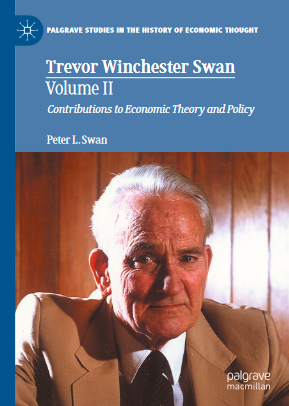30 P. L. SWAN 1961 article had for a decade formed part of an “oral tradition” amongst the group around Trevor Swan at the Australian National University. Swan’s article, the fons et origo of this tradition, exists in five versions, only the second and third of which were published; the second in 1960, the third in 1963 (not 1968). The first version, entitled “Simple Algebra: External Balance, Internal Balance and Price Stability”, was written in November 1952 for a meeting of economists at the Australian central bank in Sydney. In this paper, the central point was made quite clearly, although Swan referred to “the ratio of the external price level (an index of the prices of exports and imports in domestic currency) to the domestic cost-level represented by the money wage-level”, rather than to the relative prices of traded and non-traded goods (1952, p. 2). The second version, written in June 1953 for a seminar at the Australian National University, under the title “Economic Control in a Dependent Economy”, emphasized that the terms of trade between export and import prices were taken as given. To treat the terms of trade as a datum is in sharp contrast with most of the literature; the argument is directly applicable only to a ‘dependent economy’—i.e. a small country which trades in world markets that are competitive in the sense that the prices it receives for exports and pays for imports are independent of its domestic conditions of supply and demand.1 However, for a majority of countries (by number, not by weight), and typically for those exporting chiefly primary products, this assumption is closer to reality than the usual textbook situation in which the terms of trade are regarded as sensitive to domestic changes and home-trade products are more or less inter- changeable with exports” (1953, pp. 53f). Here Swan added a crucial footnot
چکیده فارسی
30 مقاله P. L. SWAN 1961 برای یک دهه بخشی از "سنت شفاهی" در میان گروه اطراف ترور سوان در دانشگاه ملی استرالیا را تشکیل می داد. مقاله سوان، fons et origo of this سنت، در پنج نسخه وجود دارد که تنها نسخه دوم و سوم آن منتشر شده است. دومی در سال 1960، سومی در سال 1963 (نه 1968). اولین نسخه با عنوان "جبر ساده: تعادل خارجی، تعادل داخلی و ثبات قیمت" در نوامبر 1952 برای نشستی از اقتصاددانان در بانک مرکزی استرالیا در سیدنی نوشته شد. در این مقاله، نکته اصلی کاملاً واضح بیان شد، اگرچه سوان به «نسبت سطح قیمت خارجی (شاخص قیمتهای صادرات و واردات به ارز داخلی) به سطح هزینه داخلی که توسط دستمزد پول نشان داده میشود اشاره کرد. سطح» به جای قیمت های نسبی کالاهای مبادله شده و غیرمعامله (1952، ص 2). نسخه دوم، که در ژوئن 1953 برای سمیناری در دانشگاه ملی استرالیا، تحت عنوان "کنترل اقتصادی در یک اقتصاد وابسته" نوشته شد، تاکید کرد که شرایط تجارت بین قیمت صادرات و واردات همانطور که داده شده است در نظر گرفته شده است. در نظر گرفتن شرایط تجارت به عنوان یک داده، در تضاد شدید با بیشتر ادبیات است. این استدلال مستقیماً فقط برای «اقتصاد وابسته» قابل استفاده است - یعنی. کشور کوچکی که در بازارهای جهانی رقابتی تجارت می کند به این معنا که قیمت هایی که برای صادرات دریافت می کند و برای واردات می پردازد مستقل از شرایط داخلی عرضه و تقاضای آن است. وزن) و معمولاً برای کسانی که عمدتاً محصولات اولیه صادر می کنند، این فرض به واقعیت نزدیکتر از وضعیت معمول کتاب درسی است که در آن شرایط تجارت به عنوان حساس به تغییرات داخلی در نظر گرفته می شود و محصولات تجارت داخلی کم و بیش با صادرات قابل تغییر هستند. ” (1953، ص 53f). در اینجا سوان یک پاورقی مهم اضافه کرد
ادامه ...
بستن ...
Peter L. Swan
UNSW Australia
NSW Sydney, NSW, Australia
ISSN 2662-6578 ISSN 2662-6586 (electronic)
Palgrave Studies in the History of Economic Thought
ISBN 978-3-031-23806-2 ISBN 978-3-031-23807-9 (eBook)
https://doi.org/10.1007/978-3-031-23807-9
© The Editor(s) (if applicable) and The Author(s), under exclusive license to Springer
Nature Switzerland AG 2023
This work is subject to copyright. All rights are solely and exclusively licensed by the
Publisher, whether the whole or part of the material is concerned, specifically the rights
of translation, reprinting, reuse of illustrations, recitation, broadcasting, reproduction on
microfilms or in any other physical way, and transmission or information storage and
retrieval, electronic adaptation, computer software, or by similar or dissimilar methodology
now known or hereafter developed.
The use of general descriptive names, registered names, trademarks, service marks, etc.
in this publication does not imply, even in the absence of a specific statement, that such
names are exempt from the relevant protective laws and regulations and therefore free for
general use.
The publisher, the authors, and the editors are safe to assume that the advice and informa-
tion in this book are believed to be true and accurate at the date of publication. Neither
the publisher nor the authors or the editors give a warranty, expressed or implied, with
respect to the material contained herein or for any errors or omissions that may have been
made. The publisher remains neutral with regard to jurisdictional claims in published maps
and institutional affiliations.
This Palgrave Macmillan imprint is published by the registered company Springer Nature
Switzerland AG
The registered company address is: Gewerbestrasse 11, 6330 Cham, Switzerland
ادامه ...
بستن ...










